 Compressed gas cylinders can present a wide range of hazards because of their pressure, contents, and cylinder weight. Hazards of gases include potential for explosion and fire, toxicity, exothermic chemical reactions, increased rates of combustion, risk of asphyxiation, and corrosiveness. Because of these hazards and many others, NFPA cylinder restraint requirements and many state laws and codes require the implementation of safety precautions. These requirements are for the safe storage of compressed gas cylinders.
Compressed gas cylinders can present a wide range of hazards because of their pressure, contents, and cylinder weight. Hazards of gases include potential for explosion and fire, toxicity, exothermic chemical reactions, increased rates of combustion, risk of asphyxiation, and corrosiveness. Because of these hazards and many others, NFPA cylinder restraint requirements and many state laws and codes require the implementation of safety precautions. These requirements are for the safe storage of compressed gas cylinders.
Whether your company has just received a visit from NFPA or you are setting up a new work environment, understanding how to safely store and handle compressed gas cylinders is very important.
Although there are many NFPA cylinder restraint requirements, following are the most important ones that should be your top priority:
1. Store Toxic Gas Cylinders in a Secured Area
Toxic gases that have a NFPA health rating of 3 and 4 as well as nitrous oxide gas and pyrophoric gases should be stored in a secured area that is protected from unauthorized access. These may include a locked cage or a locked storage room.
2. Store Dangerous Gases Separately from Each Other
Gases that pose health hazards as well as other dangerous types such as corrosive gases, oxidizing gases, flammable gases, and pyrophoric gases should be stored separately from each other. If you are storing them in the same room, then make sure that there is adequate spacing (at least 20 feet) between them. You should also use fire barriers for added protection.
3. Secure Cylinders with Chains or Racks
Cylinder restraints are important as they prevent gas cylinders from tipping over. If a gas cylinder tips over, it can cause crushing injuries due to its heavy weight and also become a dangerous projectile in case its valve is sheared off. If that happens, the cylinder will move at an extremely high speed due to the highly pressurized gas escaping through a small hole, colliding with other cylinders and potentially causing a dangerous situation. Because of this, NFPA guidelines require that all compressed gas cylinders of all sizes are restrained securely at all times so that they don’t fall or tip over.
It is recommended that you only use approved storage racks so that the cylinders are adequately secured by metal chains, straps,or other approved materials, to prevent cylinders from being knocked over.
4. Make Sure That the Racks Are Noncombustible
Use only racks that are constructed of noncombustible materials and chains. For some gases, you can also use racks made of limited-combustible materials. Secure all cylinders (full or empty) with adequate racks. Use chains instead of straps. If you want to use straps, then make sure they are noncombustible.
5. Secure the Restraints to a Fixed Surface
Secure the cylinders with chains or straps connected to a wall bracket or other fixed surface. You can also use a cylinder stand for this purpose as it is designed to prevent cylinders from falling. Also keep in mind that the restraints must be fastened on the upper half of the cylinder, which is approximately 2/3 up the cylinder.
JT Racking Systems is dedicated to supplying our customers with the highest quality Cylinder Storage Racks available. Our Cylinder Storage Racks are fully made in America with US Steel and Chain, and are Welded and Powder Coated at our facility in Southern California. Regularly used in hospitals, universities, or laboratory gas storage rooms, our cylinder racks can be utilized wherever securing of cylinders is needed. We ship anywhere in the United States from our Los Angeles area facility, at the best prices on the market since you are buying direct from the manufacturer.
